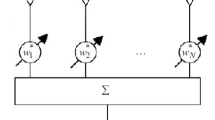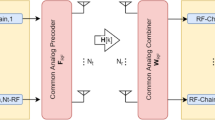Abstract
The presented work explores novel methods for synthesizing approximately frequency independent array factors at lower hardware complexity for wideband beamforming applications. The proposed approach employs 2-D infinite impulse response (IIR) digital beam filters together with nested uniform linear arrays (ULAs). The array is designed to have multiple levels of nesting. Each level of nesting consists of a ULA covering a temporal subband of the incident wideband signal. The use of nested arrays provides the required aperture size using a smaller number of elements compared to using a single ULA to capture the entire wideband signal. The use of different levels of nesting allows the operation of the digital processor for each sub-band at different clock rates. This is a hierarchical approach that saves both digital VLSI hardware and power consumption. The 2-D IIR digital beam filters that process each subband signal from each of the nested subarray achieves wideband beamforming. Simulations illustrate approximately frequency independent passbands as required in wideband beamforming.










Similar content being viewed by others
Explore related subjects
Discover the latest articles and news from researchers in related subjects, suggested using machine learning.References
Applebaum, S., & Chapman, D. (1976). Adaptive arrays. IEEE Transactions on Antennas and Propagation, 24(5), 585–597.
Ariyarathna, V., Kulasekera, S., Madanayake, A., Suarez, D., Cintra, R., & Bayer, F. (2015a). Multi-beam 4 GHz microwave apertures using current-mode DFT approximation on 65 nm CMOS. In IEEE international microwave symposium (IMS).
Ariyarathna, V., Madanayake, A., Agathoklis, P., & Bruton, L. T. (2015b). Wideband mixed microwave-digital 2-D IIR beam filters for nested uniform linear array processing. In IEEE 10th international conference on information, communications and signal processing (ICICS).
Bruton, L. T. (2003). Three-dimensional cone filter banks. IEEE Transactions on Circuits and Systems I: Fundamental Theory and Applications, 50(2), 208–216.
Bruton, L. T., & Bartley, N. (1985). Three-dimensional image processing using the concept of network resonance. IEEE Transactions on Circuits and Systems, 32(7), 664–672.
Chen, H., Zhao, Y., Li, D., Liu, C., & Wang, W. (2013). Least squares approach to the design of frequency invariant beamformer with sensor delay lines in subbands. In IET international radar conference (pp. 1–8).
Chen, T. (1993). Unified eigenfilter approach: With applications to spectral/spatial filtering. In IEEE international symposium on circuits and systems (ISCAS ’93) (pp. 331–334).
Dewdney, P., Hall, P., Schilizzi, R., & Lazio, T. (2009). The square kilometre array. Proceedings of the IEEE, 97(8), 1482–1496.
Glisson, T. (2011). Introduction to circuit analysis and design. Dordrecht: Springer. https://books.google.com/books?id=7nNjaH9B0_0C.
Huang, L., Chen, Y., & Li, M. (2009). Multirate method for constant beamwidth beamforming of nested array. In 5th international conference on wireless communications, networking and mobile computing (pp. 1–4).
Liu, W., & Weiss, S. (2010). Wideband beamforming: Concepts and techniques. Hoboken: Wiley.
Madanayake, A., & Bruton, L. T. (2008). A speed-optimized systolic array processor architecture for spatio-temporal 2-D IIR broadband beam filters. IEEE Transactions on Circuits and Systems I: Regular Papers, 55(7), 1953–1966.
Madanayake, A., Belostotski, L., Wijenayake, C., & Bruton, L. T. (2011). Analog 2-D fan filters from discrete domain transfer functions. In IEEE international symposium on circuits and systemds (ISCAS) (pp. 1652–1655).
Madanayake, A., Wijenayake, C., Wijayaratna, S., Acosta, R., & Hariharan, S. (2014). 2-D-IIR time-delay-sum linear aperture arrays. IEEE Antennas and Wireless Propagation Letters, 13, 591–594.
Moazzen, I., & Agathoklis, P. (2011). Broadband beamforming using 2D trapezoidal filters and nested arrays. In IEEE Pacific rim conference on communications, computers and signal processing (PacRim) (pp. 488–493).
Moazzen, I., & Agathoklis, P. (2013). Efficient implementation of broadband beamformers using nested hexagonal arrays and frustum filters. IEEE Transactions on Signal Processing, 61(19), 4796–4805. doi:10.1109/TSP.2013.2274279.
Moazzen, I., Harrison, S., Agathoklis, P., & Driessen, P. (2013). A nested microphone array for broadband audio signal processing. In IEEE Pacific rim conference on communications, computers and signal processing (PACRIM) (pp. 377–382). doi:10.1109/PACRIM.2013.6625506.
Nishikawa, K., Yamamoto, T., Oto, K., & Kanamori, T. (1992). Wideband beamforming using fan filter. In Proceedings of the IEEE international symposium on circuits and systems (ISCAS ’92) (Vol. 2, pp. 533–536). doi:10.1109/ISCAS.1992.230137.
Pal, P., & Vaidyanathan, P. (2010). Nested arrays: A novel approach to array processing with enhanced degrees of freedom. IEEE Transactions on Signal Processing, 58(8), 4167–4181.
Phadke, A. (1999). Handbook of electrical engineering calculations. Electrical and computer engineering. London: Taylor & Francis. https://books.google.com/books?id=OQ9bDze6C5gC.
Pozar, D., Schaubert, D., Antennas, I., & Society, P. (1995). Microstrip antennas: The analysis and design of microstrip antennas and arrays. Electrical engineering, antennas and propagation. New York: Wiley.
Van Trees, H. (2004). Optimum array processing: Detection, estimation, and modulation theory. Hoboken: Wiley.
Wijenayake, C., Madanayake, A., & Bruton, L. T. (2012). Broadband multiple cone-beam 3-D IIR digital filters applied to planar dense aperture arrays. IEEE Transactions on Antennas and Propagation, 60(11), 5136–5146. doi:10.1109/TAP.2012.2211316.
Zheng, Y. R., Goubran, R. A., & El-Tanany, M. (2000). A broadband adaptive beamformer using nested arrays and multirate techniques. In IEEE workshop on digital signal processing, TX, USA.
Zheng, Y. R., Goubran, R. A., & El-Tanany, M. (2004). Experimental evaluation of a nested microphone array with adaptive noise cancellers. IEEE Transactions on Instrumentation and Measurement, 53(3), 777–786. doi:10.1109/TIM.2004.827304.
Acknowledgments
This work is supported by NSF ECCS Award 1408361.
Author information
Authors and Affiliations
Corresponding author
Appendix
Appendix
1.1 Review on 2-D IIR digital beam filters
The proposed method uses 2-D IIR beam filters in each subband. The beam filters have a line shaped passband in the 2-D spatio-temporal frequency domain (Madanayake and Bruton 2008) for directionally enhancing a propagating spatio-temporal uniform plane wave based on the direction of propagation. First-order 2-D IIR digital beam filters have an \(\mathbf{z}\)-domain transfer function (Madanayake and Bruton 2008)
where the filter coefficients \(b_{ij} = \frac{R+ (-1)^i (2L_x/{\varDelta }x) + (-1)^j (2L_{ct}/(c{\varDelta }T_s))}{R + (2L_x/{\varDelta }x) + (2L_{ct}/(c{\varDelta }T_s)) }~\text {with}~i+j \ne 0\). \(2L_{x}/{\varDelta }x = \cos \theta \) and \(2L_{ct}/(c{\varDelta }T_s) = \sin \theta \) sets the orientation \(\theta \) of the passband (\(L_x \ge 0\) is a spatial inductance, \(L_{ct}\ge 0\) is a temporal inductance, and c is wave propagation speed). The beam passband oriented at \(\theta \) in \(\omega _x,~\omega _{ct}\) domain corresponds to directionally filtering a plane wave arriving at an angle \(\psi \) where \(\tan \theta = \sin \psi \) and \(\omega _x,~\omega _{ct}\) refer to the spatial and wave speed normalized temporal frequencies. Variables \(z_x,~z_{ct}\) correspond to the \(\mathbf{z}\)-domain transformations of discretized (x, ct).
Further, the termination \(R>0\) sets the sharpness (i.e., selectivity) of the beam passband and \({\varDelta }T_s, ~{\varDelta }x\) corresponds to the reciprocals of temporal and spatial sampling frequencies, respectively. It is noted that the transfer function given in (7) is derived by applying the 2-D bilinear transform \(s_k = \frac{1-z_k^{-1}}{1+z_k^{-1}}\), \(k \in \{ x, ct \}\) to the continuous domain prototype 2-D transfer function
which corresponds to a resistively terminated 2-D passive prototype network (Bruton and Bartley 1985). Fig. 11a shows the normalized magnitude frequency response in 2-D frequency domain for the Nyquist square \(-\pi< \omega _x< \pi , -\pi< \omega _{ct} < \pi \). Frequency warping, which is inherent in discrete digital systems synthesized from bi-linear transforms (Phadke 1999), results in the twisting of the beam-shaped passband towards the edges.
1.2 Array factor of a generic 2-D IIR beamfilter
Figure 12 illustrates the array factor of the 2-D IIR beamfilter given by (7). It should be noted that the plot has been drawn nullifying the effect warping by using pre-warping technique described in Sect. 4.1.
Rights and permissions
About this article
Cite this article
Ariyarathna, V., Madanayake, A., Agathoklis, P. et al. Mixed microwave-digital and multi-rate approach for wideband beamforming applications using 2-D IIR beam filters and nested uniform linear arrays. Multidim Syst Sign Process 29, 703–718 (2018). https://doi.org/10.1007/s11045-016-0422-3
Received:
Revised:
Accepted:
Published:
Issue Date:
DOI: https://doi.org/10.1007/s11045-016-0422-3






